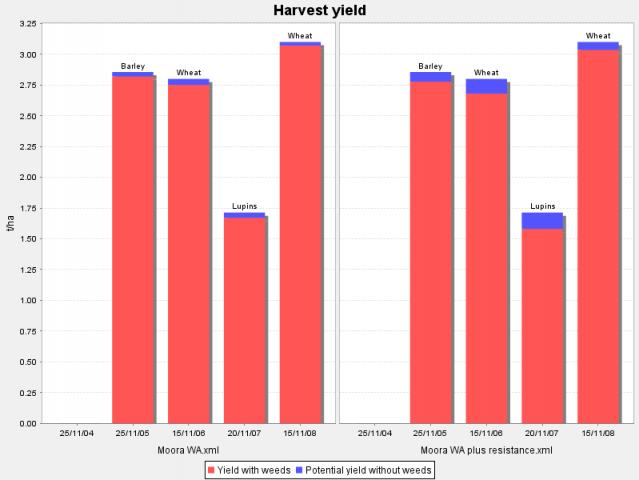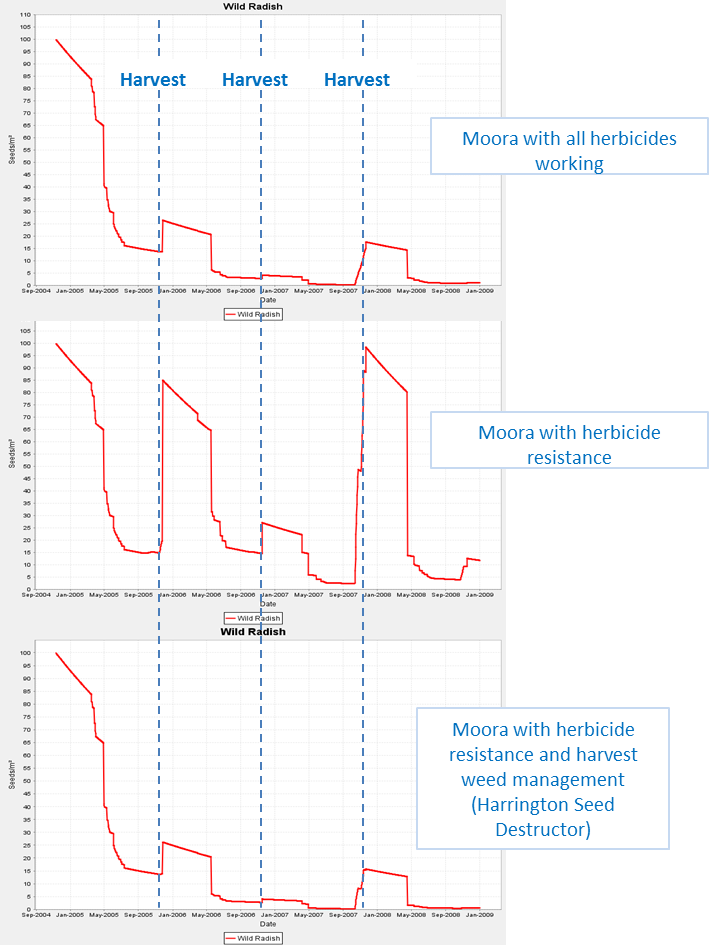Moora, WA - herbicide resistance in wild radish
This Western Australian scenario is set in Moora between 2004 and 2008.
This is a barley - wheat - lupin - wheat rotation with wild radish and annual ryegrass.
In the original scenario, all herbicides are working and all there is no harvest weed seed management (all chaff is spread out the back of the header) (see Table 1 below for management events). In the modified scenario, wild radish is beginning to develop resistance to metosulam (Eclipse™, a Group B herbicide) and atrazine (a Group C herbicide). In a final scenario, harvest weed seed management is used to collect the wild radish seed at harvest using a Harrington Seed Destructor™.
| Date | Management events for the original and modified scenarios | Management events for the final scenario (with harvest weed seed management) |
|---|---|---|
| 15/04/05 | Spray: Glyphosate/Logran | - |
| 15/05/05 | Sow: Barley, disc seeding | - |
| 15/05/05 | Spray: Sprayseed/Trifluralin | - |
| 06/07/05
|
Spray: Eclipse | - |
| 25/11/05 | Harvest: Barley harvested, all chaff spread/normal harvest used | Harvest: Barley harvested, Harrington Seed Destructor used |
| 05/05/06 | Spray: Glyphosate/Logran | - |
| 20/05/06 | Sow: Wheat, disc seeding | - |
| 20/05/06 | Spray: Sprayseed/Trifluralin | - |
| 25/06/06 | Spray: Eclipse | - |
| 15/11/06 | Harvest: Wheat harvested, 2.8t/ha of potential yield, all chaff spread/normal harvest used | Harvest: Wheat harvested, Harrington Seed Destructor used |
| 30/05/07 | Spray: Glyphosate 450 | - |
| 01/06/07 | Spray: Simazine/Atrazine | - |
| 01/06/07 | Sow: Lupins, disc seeding | - |
| 10/07/07 | Spray: Simazine | - |
| 17/09/07 | Spray: Crop-top Gramoxone | - |
| 20/11/07 | Harvest: Lupins harvested, crop topping used | Harvest: Lupins harvested, Harrington Seed Destructor used |
| 20/04/08 | Spray: Glyphosate/Logran | - |
| 19/05/08 | Spray: Sprayseed/Trifluralin | - |
| 20/05/08 | Sow: Wheat, disc seeding | - |
| 08/07/08 | Spray: Eclipse | - |
| 15/11/08 | Harvest: wheat harvested, 3.1t/ha of potential yield, all chaff spread/normal harvest used | Harvest: wheat harvested, harrington seed destructor used |
What happens when wild radish develops resistance?
In the first scenario (Figure 1 - left and Figure 2 - top), there is no herbicide resistance in wild radish and it is controlled well. In the second scenario, (Figure 1 - right and Figure 2 - middle), the wild radish is developing resistance to metosulam (Eclipse™, a Group B herbicide) and atrazine (Group C herbicide). There is only a slight decrease in yield, shown by the red bars (with weed competition).

But by looking at the seed production of wild radish, you can see that the number of wild radish seeds has increased substantially even though the herbicide resistance is only developing. A few years later, with a more resistant population, the wild radish seed production per year is likely to be substantial. This will eventually lead to considerable yield losses and a prolonged seedbank.

What happens when you add harvest weed seed management?
With developing herbicide resistance, it is advisable to stop seed set as much as possible. In the final scenario (Figure 2 - bottom), a Harrington Seed Destructor™ was used in all of the harvests, collecting a lot of the wild radish seed. The wild radish seedbank is declining each year leading to a manageable seedbank and one where dry sowing might become feasible.
Other techniques to reduce the wild radish seedbank?
There are many integrated weed management techniques that can be used (and are available in the Weed Seed Wizard). These might include:
- rotating herbicides (after doing a resistance test on the wild radish to determine which herbicides still work)
- increasing crop seeding rates for greater crop competition
- changing the crop rotation with different herbicide modes of action
- having a fallow year
- having a pastures phase with grazing
- changing the time of sowing and herbicide application
- autumn tickle.
For more information refer to integrated weed management links in the See also section or look at the Integrated Weed Management manual (External links section) and discover how they may fit into your farm.


